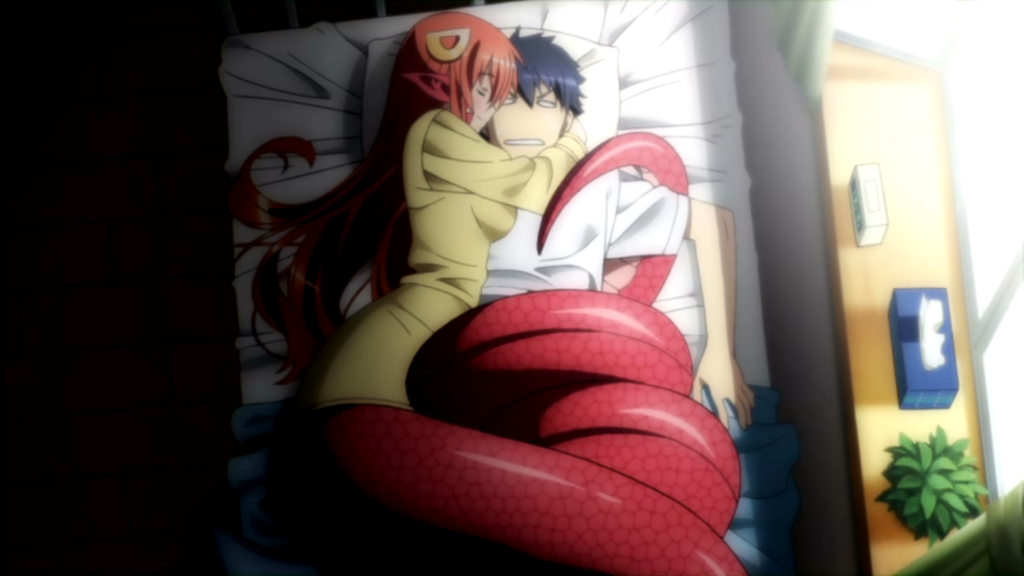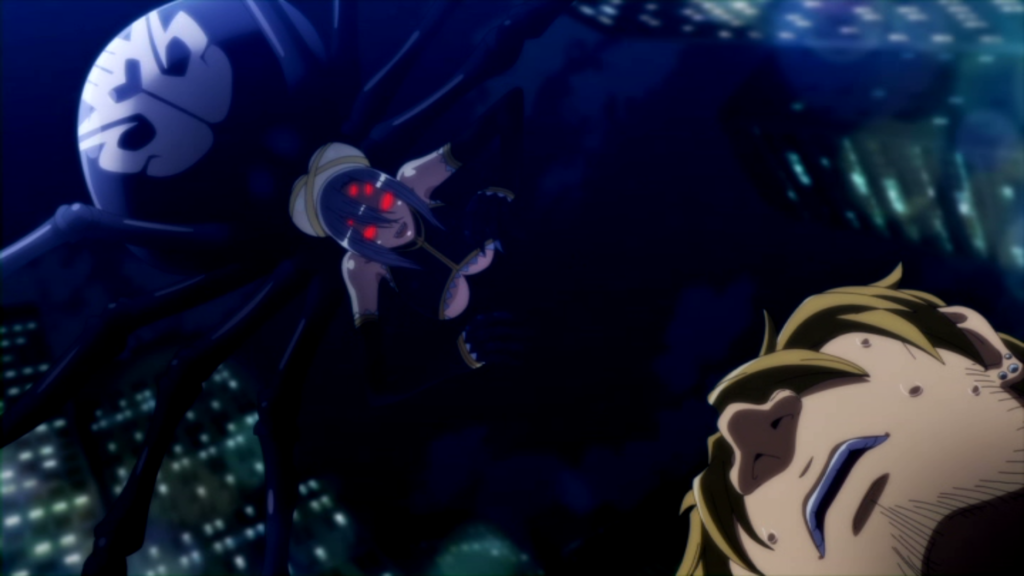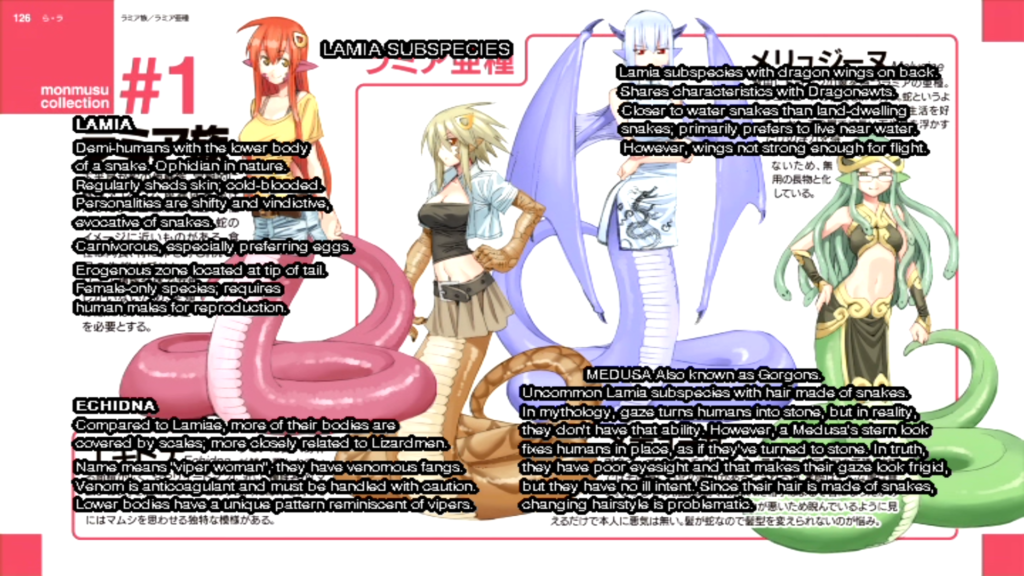Monster Musume Review: Is It A Wonderful Life?
NSFW Warning: While we’ve strived to keep visual assets safe, this review discusses aspects of the title that aren’t, so reader discretion is advised. All screenshots are sourced from the DVD release.
Before beginning my review in earnest, let me share a brief, yet memorable anecdote of my time with Monster Musume: Everyday Life with Monster Girls. Back in the summer of ’15, I was enduring a miserable part-time job where my only solace was the bookstore a mere stone’s throw away. If I had time before a shift, I’d pop in and buy a book to read on my break.
One day, that book was Monster Musume Volume 4. As it turns out, I wasn’t actually alone in the break room and the cheery coworker who had no regard for personal space, suddenly yanked it out of my hands and flicked through… before quietly handing it back to me and quickly leaving the room. I never saw him again. Clearly, he was in awe of my superior taste.
If you’ve yet to hear of Okayado’s now-infamous series, depending on your constitution, that may be a blessing or a curse. Bringing back the once pandemic, now-endangered harem comedy genre with a twist any sane person would raise eyebrows at, you might be surprised to learn that Monster Musume‘s unique flavour not only works, but does it surprisingly well!
Kimihito Kurusu is a young man who’s considerate to a fault, living in a world that has only recently lifted the lid on the existence of non-humans, who are integrating into human society for the first time. When we first meet Kimihito, he wakes in the constricting embrace of the besotted Miia, a “lamia” (like a mermaid, but a snake instead of a fish). The romantic gesture almost kills him, until an emergency fondling of her tail’s tip results in more than one kind of release. This opening scene should serve as a perfect litmus test – if you haven’t already clocked out and contacted the RSPCA, feel free to read on.

As the name implies, this series is essentially about Kimihito’s daily life with the various monster girls who, one way or another, end up residing with him as their home-stay sponsor. The cast is as diverse in personality as they are in design, which is saying a lot when his other house-mates include a bird-brained harpy, honour-bound centaur and a tragedy-obsessed mermaid. The daily hi jinks they get caught up in varies, but never falls into overused anime trope territory – there are fortunately no butchered plays or, surprisingly, beach episodes to be seen here.
While a lot of scenarios ultimately act as preludes to female cast members being undressed or groped, the series never undervalues its potential to tell a genuinely meaningful story. One invaluable example, is the character Rachnera.
As she has a mostly human top-half and the lower half of a large spider, just one look at her design may elicit feelings of fear or disgust from viewers, which Monster Musume latches onto with perfect precision. Utilising arachnophobia, the common human fear, the series cleverly spins its narrative web to act as a symbol for perceptions of demi-humans in a way that is driven home to audiences, inviting them to reflect on earlier judgements.

For a series created largely for titillation, the world-building of Monster Musume is surprisingly deep, allowing for a variety of stories to be told in the space of such a short series. For example, one episode follows the non-human Special Ops unit MON dealing with a hostage situation, while the next is a smaller scale story about the monster girls struggling to care for a cold-stricken Kimihito.
Some may call this an inconsistent tone, but it’s all held together by one unifying element – the comedy. This usually consists of characters accidentally stumbling into sexual situations, like a running gag of Suu doing whatever she can to absorb someone’s excess moisture (from a spilled drink etc), or situations deliberately framed as something else, like a certain egg-laying scene. If you don’t like sexual humour that’s rather… in your face, I doubt you’ll find much amusement in Monster Musume, but otherwise, you might find yourself laughing as much as I did. I’d argue that the nudity in this series fits its comedic purpose perfectly and is just too ridiculous to actually be arousing.

What I do find inconsistent however, is the overall soundtrack compilation. I can’t fault the quality of the individual tracks, but as a collected selection, the different genres don’t really fit together. Some sound perfectly suited for a JRPG, with tracks like “Addicted to Tragic Love” feeling inspired by Final Fantasy IX, while others feel more akin to a classic ball or whimsical Super Mario-esque game. To reiterate, I don’t think Hiroaki Tsutsumi and manzo’s compositions are bad – I really like the tracks individually, but they’re just mismatched as an overall selection.
The animation by Lerche and Seva is top-notch quality, especially for a TV anime, with there being no moments at all where I’ve thought anything looked off-model or sub-par in any way. We were supplied a DVD copy for review and just based on the subtitle quality, which is blocky and makes the text-heavy end cards almost unreadable, I’d say Monster Musume is a great reason to upgrade to Blu-ray, if you haven’t already. The DVD also suffers from noticeable banding during moments of darker colour.

Included in this release are both the original Japanese audio track and an English language dub, but I can safely say that I vastly prefer the former. The Japanese language cast overall feels as though they have a better handle on their characters’ personality and quirks, with there just being no competition for Ari Ozawa’s happy, ditzy Papi or Sora Amamiya’s obsessively devoted Miia in particular.
Initially, MVM Films only supplied us with DVD discs for the purpose of this review, but due to an early shipment, we were able to get our hands on a finished retail copy of the Collector’s Edition – and it’s one of the company’s best releases to date. Alongside the series on DVD and Blu-ray, this release includes the soundtrack CD, a sizeable pile of art cards depicting the various monster girl species and a brief “Pin-Up” Booklet of artwork and comics.
Essentially, the release is a replica of Sentai Filmworks’ North American Premium Box Set, without some of the more unnecessary tat and in outer packaging that’s a little less conspicuous (which is great when you live with others like I do). In fact, the outer rigid box accidentally missing the title on the spine could actually save you some awkward questions in the future!
My only issue with the Collector’s Edition, would be the thin paper used for the print-heavy booklet, resulting in things like panel borders for comics being visible through the key art on the previous page.
Most remarkably however, is how reasonably priced this release is compared to other anime. With a price-tag of £41.99 on places like Amazon (at time of writing), it’s probably best to act fast – MVM have confirmed the set is now out-of-print and their own store is almost out of stock on pre-sales alone. If you miss the Collector’s Edition however, the series is set to be released on barebones DVD and Blu-ray from 9th April 2018.
The title that arguably kicked off the recent Monster Girl craze, there’s a reason why Monster Musume was a near constant on the New York Times’ now-defunct Best Selling Manga list, beyond mere curiosity or the increasing degeneracy of society. It isn’t even about looking beyond the strange premise, but by embracing it and sitting back to enjoy the ridiculousness it allows, you’ll surely have an enjoyable Everyday Life with Monster Girls.


